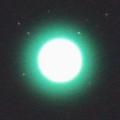
|
Surprisingly, a great outburst occured on Oct. 24 and now it becomes so bright as 2.5 mag, visible with naked eyes! Almost stellar with naked eyes, so it looks like a nova. It looks like a planetary nebula with a diameter of several arcmin through binoculars or telescopes. It was observed as 14.5 mag in July, then it had been fading down to 17 mag until Oct. 23 as predicted. This comet was also in great outburst at the discovery in 1892 and became so bright as 5 mag. At that time, the comet faded after the first outburst, but soon brightened again in the second outburst. The further brightness is uncertain. But the comet will be observable in excellent condition for a while after this.
Date(TT) R.A. (2000) Decl. Delta r Elong. m1 Best Time(A, h)
Oct. 27 3 51.15 50 16.7 1.630 2.447 136 2.5 1:33 (180, 75)
Nov. 3 3 43.93 50 35.6 1.621 2.474 141 2.7 0:58 (180, 74)
|
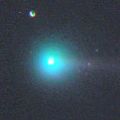
|
Now it is 5.3 mag (Oct. 25, Juan Jose Gonzalez), bright even in the extremely low sky. It approaches down to 0.4 A.U. to the sun on Oct. 28, and it was expected to reach to 4 mag. But actually, it was fainter than expected by 1 mag. In the Northern Hemisphere, it locates extremely low, slightly over the horizon, in the evening sky until late October. Then it will never be observable again. In the Southern Hemisphere, it will appear in the evening sky in early November, then it keeps observable while fading gradually, although it will not locate very high.
Date(TT) R.A. (2000) Decl. Delta r Elong. m1 Best Time(A, h)
Oct. 27 15 7.38 0 3.2 0.720 0.404 20 4.1 18:36 ( 87, 2)
Nov. 3 16 8.31 -21 53.6 0.775 0.427 24 4.4 18:30 ( 64, -3)
|
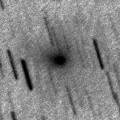
|
New bright comet. Now it is 10.6 mag (Oct. 14, Mike Linnolt). It must have been locating observable and brightening gradually in the Northern Hemisphere for a while, but it was not discovered until early October. In the Northern Hemisphere, it will be getting lower and lower, then it will be unobservable in early November. In the Southern Hemisphere, it will be unobservable for 1 month after mid November, but it will be observable in good condition at 10 mag from mid December to February. In the Northern Hemisphere, it will appear in the evening sky at 11 mag in March, then it keeps observable while fading gradually until May.
Date(TT) R.A. (2000) Decl. Delta r Elong. m1 Best Time(A, h)
Oct. 27 17 10.43 -20 58.1 1.731 1.252 45 10.7 18:36 ( 53, 12)
Nov. 3 17 8.91 -24 55.5 1.787 1.183 38 10.5 18:30 ( 54, 6)
|
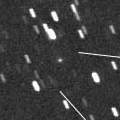
|
It will reach to 6 mag in January, and will be observable in good condition. Now it is 15.4 mag (Oct. 7, Masayuki Suzuki), but very diffuse. Brightening rapidly, and it will become visible visually soon, although it was not visible visually, fainter than 14.6 mag, on Oct. 5 (Seiichi Yoshida). In the Northern Hemisphere, it keeps observable all night until mid December, then keeps observable until early February, when it fades down to 7.5 mag. In the Southern Hemisphere, it is not observable until late December. But after that, it keeps observable until it fades out.
Date(TT) R.A. (2000) Decl. Delta r Elong. m1 Best Time(A, h)
Oct. 27 14 20.80 86 36.0 1.199 1.674 99 12.9 18:36 (176, 34)
Nov. 3 15 11.71 85 53.9 1.087 1.603 100 12.3 18:30 (175, 35)
|
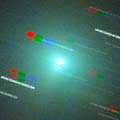
|
It reached to 7.2 mag on July 14 (Maik Meyer), then it faded down to 9.0 mag on Aug. 13 (Carlos Labordena). It had been unobservable for a while. But in the Southern Hemisphere, it will appear in the morning sky in late October at 13 mag, then it keeps observable while fading gradually. In the Northern Hemisphere, it will appear again at 14 mag in the very low sky at dawn in mid November. But it will be fading while keeping extremely low.
Date(TT) R.A. (2000) Decl. Delta r Elong. m1 Best Time(A, h)
Oct. 27 12 18.01 -31 8.4 2.386 1.612 30 12.8 4:50 (303, -8)
Nov. 3 12 14.61 -33 1.7 2.397 1.694 35 13.1 4:56 (309, -3)
|

|
It was 14.1 mag on Oct. 1 (S. G. McAndrew), brightening well as expected. It will reach to 11 mag in 2008 spring. It will keep bright for a long time, however, it keeps moving in the southern sky for a while after this. In the Northern Hemisphere, it will appear at 13 mag from October to December in a short time, but very low and hard to observe. However, it will be visible visually at 11 mag in the evening sky from March to June in 2008. Then it becomes unobservable again. But it will appear in the morning sky again at 13 mag at the end of 2008, then it keeps bright and observable for a while.
Date(TT) R.A. (2000) Decl. Delta r Elong. m1 Best Time(A, h)
Oct. 27 9 7.35 -38 56.7 3.964 3.739 69 13.5 4:50 (337, 11)
Nov. 3 9 14.87 -40 12.3 3.876 3.695 72 13.4 4:56 (342, 12)
|

|
Now it is faint as 14.1 mag (Oct. 5, Seiichi Yoshida). It has been observable since late July, but it keeps faint in this season. It has never be brighter than 14 mag yet.
Date(TT) R.A. (2000) Decl. Delta r Elong. m1 Best Time(A, h)
Oct. 27 6 30.52 30 31.0 5.454 5.961 116 13.5 4:11 ( 0, 86)
Nov. 3 6 29.85 30 35.6 5.360 5.963 123 13.5 3:43 ( 0, 86)
|
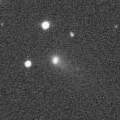
|
It brightened rapidly, and it is already bright and visible visually at 13.4 mag (Oct. 6, Seiichi Yoshida). It is observable at 13.5 mag in good condition from autumn to winter.
Date(TT) R.A. (2000) Decl. Delta r Elong. m1 Best Time(A, h)
Oct. 27 0 30.40 24 18.6 0.833 1.784 155 13.6 22:08 ( 0, 79)
Nov. 3 0 26.64 24 49.0 0.837 1.764 149 13.5 21:37 ( 0, 80)
|
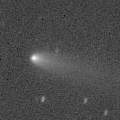
|
Now it is bright as 12.7 mag (Oct. 11, Juan Jose Gonzalez). Strongly condensed and easy to see visually. It is observable in very good condition at 13 mag for a while in this autumn.
Date(TT) R.A. (2000) Decl. Delta r Elong. m1 Best Time(A, h)
Oct. 27 23 59.00 -14 42.0 1.491 2.333 138 13.9 21:37 ( 0, 40)
Nov. 3 23 59.10 -14 38.7 1.558 2.344 132 14.1 21:10 ( 0, 40)
|
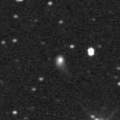
|
It is already bright and visible visually at 13.5 mag (Oct. 11, Juan Jose Gonzalez). It will reach to 10.5 mag and will be observable in good condition in 2008 autumn. It keeps observable in good condition for a long time while the comet is getting brighter slowly.
Date(TT) R.A. (2000) Decl. Delta r Elong. m1 Best Time(A, h)
Oct. 27 21 13.07 -7 16.3 3.785 4.157 105 14.1 18:51 ( 0, 48)
Nov. 3 21 13.79 -6 57.7 3.837 4.104 98 14.1 18:30 ( 2, 48)
|
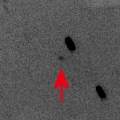
|
It will reach to 8.5 mag from January to March, and will be observable in good condition. In the Northern Hemisphere, it keeps observable in good condition until 2008 July when it becomes fainter than 18 mag. Now it is 16.5 mag (Oct. 6, Ken-ichi Kadota), but it will be brightening rapidly after this. It will be visible visually in November.
Date(TT) R.A. (2000) Decl. Delta r Elong. m1 Best Time(A, h)
Oct. 27 21 48.55 -32 25.9 1.069 1.631 104 14.6 19:27 ( 0, 23)
Nov. 3 21 51.51 -31 14.8 1.077 1.571 98 14.2 19:03 ( 0, 24)
|
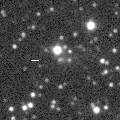
|
Now it is 15.7 mag (Sept. 16, Ken-ichi Kadota), brightening as expected. It will reach to 14 mag in next winter, and will be observable in good condition. It is expected to be visible visually. It keeps observable in good condition for a long time until 2008 spring.
Date(TT) R.A. (2000) Decl. Delta r Elong. m1 Best Time(A, h)
Oct. 27 7 33.20 24 11.2 2.281 2.670 101 14.6 4:50 (333, 78)
Nov. 3 7 40.27 23 32.4 2.190 2.658 107 14.4 4:53 ( 0, 79)
|
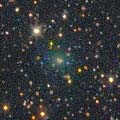
|
It reached to 13.2 mag in last spring (May 12, Carlos Labordena). But now it is not observable. In the Southen Hemisphere, it will be observable again at 15 mag in November. But in the Northern Hemisphere, it will never observable again.
Date(TT) R.A. (2000) Decl. Delta r Elong. m1 Best Time(A, h)
Oct. 27 12 38.90 -23 20.7 3.059 2.177 22 14.5 4:50 (294, -7)
Nov. 3 12 53.10 -25 42.0 3.082 2.225 25 14.7 4:56 (298, -5)
|
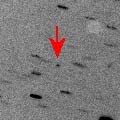
|
It brightened very rapidly in a short time, and now it reached to 15.5 mag (Oct. 1, J. Maria Ruiz M). It will be observable at 14.5-15 mag in an excellent condition from October to February. It may be visible visually, but it was not visible, fainter than 14.4 mag, on Oct. 5 (Seiichi Yoshida).
Date(TT) R.A. (2000) Decl. Delta r Elong. m1 Best Time(A, h)
Oct. 27 5 42.71 33 50.6 1.846 2.560 126 14.9 3:24 ( 0, 89)
Nov. 3 5 43.17 33 48.9 1.771 2.551 132 14.8 2:57 ( 0, 89)
|
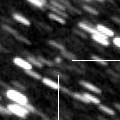
|
Now it is 15.8 mag (Sept. 2, R. Salvo). It keeps 15 mag for a long time until 2008 spring. It moves in the southen sky, so it keeps observable in good condition in the Southern Hemisphere, although it becomes low only in winter. It will never be observable again in the Northern Hemisphere.
Date(TT) R.A. (2000) Decl. Delta r Elong. m1 Best Time(A, h)
Oct. 27 16 50.99 -58 19.2 3.661 3.205 55 14.9 18:36 ( 29,-17)
Nov. 3 16 53.91 -58 46.1 3.724 3.199 51 14.9 18:30 ( 30,-19)
|
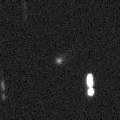
|
Now it is 15.9 mag (Sept. 8, Ken-ichi Kadota), brightening as expected. It will reach to 13.5 mag in the southern sky in 2008 spring and summer. In the Southern Hemisphere, it keeps observable for a long time after this. But in the Northern Hemisphere, it will be lower than 10 degree in November. Then it keeps locating extremely low until January, and will be unobservable after that. Then it will be observable again at the end of 2008, when the comet will already fade down to 15 mag.
Date(TT) R.A. (2000) Decl. Delta r Elong. m1 Best Time(A, h)
Oct. 27 0 47.55 -42 34.6 2.791 3.426 122 15.1 22:25 ( 0, 12)
Nov. 3 0 40.04 -43 58.5 2.823 3.378 115 15.0 21:50 ( 0, 11)
|
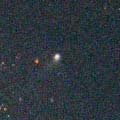
|
Now it is bright and visible visually at 14.1 mag (Oct. 5, Seiichi Yoshida). It had been observable in good conditoin for a long time since spring, but it will be getting lower and lower after this, and will be unobservable in November. But it will be observable at 14 mag at high location again in 2008 spring.
Date(TT) R.A. (2000) Decl. Delta r Elong. m1 Best Time(A, h)
Oct. 27 16 48.31 -1 4.9 6.319 5.625 42 15.1 18:36 ( 72, 22)
Nov. 3 16 49.78 -1 0.8 6.380 5.620 37 15.1 18:30 ( 76, 18)
|
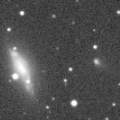
|
Now it is 15.5 mag (Oct. 1, J. Maria Ruiz M). It keeps observable in good condition until it fades out in 2008 spring. It may be visible visually, but it was not visible, fainter than 14.3 mag, on Oct. 6 (Seiichi Yoshida).
Date(TT) R.A. (2000) Decl. Delta r Elong. m1 Best Time(A, h)
Oct. 27 2 24.27 43 13.8 1.004 1.925 148 15.2 0:06 (180, 82)
Nov. 3 2 16.64 44 27.7 0.999 1.924 150 15.2 23:26 (180, 80)
|
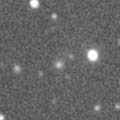
|
It was observed at 16 mag in 2007 spring and summer. Now it is not observable. In the Southern Hemisphere, it will appear again at 16 mag in winter, then it keeps 16 mag and observable in good condition until 2008 summer. In the Northern Hemisphere, it will never be observable again.
Date(TT) R.A. (2000) Decl. Delta r Elong. m1 Best Time(A, h)
Oct. 27 13 39.30 -32 7.6 3.604 2.694 20 15.3 4:50 (294,-23)
Nov. 3 13 54.12 -33 49.9 3.591 2.686 20 15.3 4:56 (298,-21)
|
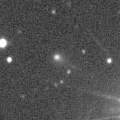
|
First return of a new periodic comet discovered in 1998 at 14 mag. Now it is 15.5 mag (Oct. 5, Yuji Ohshima), brightened as expected. It is also visible visually at 14.4 mag (Oct. 6, Seiichi Yoshida). It keeps observable at 15-16 mag in good condition until December.
Date(TT) R.A. (2000) Decl. Delta r Elong. m1 Best Time(A, h)
Oct. 27 23 48.57 2 24.0 1.697 2.576 145 15.7 21:26 ( 0, 57)
Nov. 3 23 46.64 2 38.7 1.747 2.570 137 15.8 20:57 ( 0, 58)
|
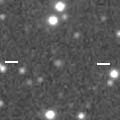
|
Now it is 16.5 mag (Sept. 16, Ken-ichi Kadota). It will reach to 12 mag in 2008 summer. In the Northern Hemisphere, it keeps observable almost all time until that while the comet is brightening gradually. However, it goes to the southern sky and will never be observable again in the Northern Hemisphere after that.
Date(TT) R.A. (2000) Decl. Delta r Elong. m1 Best Time(A, h)
Oct. 27 16 47.48 10 52.6 5.279 4.658 46 15.8 18:36 ( 83, 29)
Nov. 3 16 51.41 9 39.5 5.287 4.606 42 15.7 18:30 ( 85, 24)
|

|
Now it is 16.6 mag (Sept. 20, Ken-ichi Kadota). Although it had been observable only in the Southern Hemisphere for a long time, now it becomes observable also in the Northern Hemisphere. It keeps 16 mag until winter.
Date(TT) R.A. (2000) Decl. Delta r Elong. m1 Best Time(A, h)
Oct. 27 3 31.25 -29 34.9 3.762 4.498 132 15.9 1:13 ( 0, 25)
Nov. 3 3 25.86 -29 10.4 3.762 4.509 134 15.9 0:40 ( 0, 26)
|
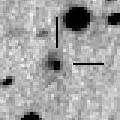
|
Now it is 16.4 mag (Oct. 3, Ken-ichi Kadota). It is expected to reach to 11 mag in 2009 summer. Because it moves in the northern sky, it keeps observable until it becomes brightest in the Northern Hemisphere.
Date(TT) R.A. (2000) Decl. Delta r Elong. m1 Best Time(A, h)
Oct. 27 6 24.26 59 3.7 5.879 6.340 113 16.1 4:06 (180, 66)
Nov. 3 6 17.39 60 3.9 5.748 6.291 119 16.0 3:31 (180, 65)
|

|
Although it has been unobservable for a while, now it is appering in the morning sky. It must be already bright as 16.5 mag. It will reach to 13.5 mag from March to July in 2008, and will be visible visually. It keeps observable in good condition for a long time until next May.
Date(TT) R.A. (2000) Decl. Delta r Elong. m1 Best Time(A, h)
Oct. 27 11 46.19 17 5.1 4.780 4.137 45 16.3 4:50 (267, 27)
Nov. 3 11 53.11 16 12.2 4.663 4.093 49 16.2 4:56 (272, 32)
|

|
It reached up to 15.5 mag in late 2006 and early 2007. Now it is fading, 16.0 mag (Oct. 6, Ken-ichi Kadota). It locates somewhat low in the south, but it is observable at 16.5 mag in autumn. It will be too low to observe in early 2008, when the comet will be fainter than 17.5 mag.
Date(TT) R.A. (2000) Decl. Delta r Elong. m1 Best Time(A, h)
Oct. 27 3 15.23 -35 13.7 3.688 4.386 129 16.3 0:57 ( 0, 20)
Nov. 3 3 0.73 -35 37.1 3.721 4.414 129 16.3 0:15 ( 0, 19)
|

|
It keeps observable in good condition in the morning sky while it brightens rapidly. It will reach to 13 mag in early December, and will be visible visually. However, it turns to fade out and move lower very rapidly after Dec. 10, and it will be unobservable within a few days. Then it will never be observable again. It locates somewhat low in the Southern Hemisphere.
Date(TT) R.A. (2000) Decl. Delta r Elong. m1 Best Time(A, h)
Oct. 27 7 29.17 31 52.0 0.963 1.540 103 16.7 4:50 (307, 85)
Nov. 3 7 42.38 31 37.5 0.810 1.461 107 16.3 4:55 ( 0, 87)
|

|
Now it is 16.8 mag (Aug. 8, Ken-ichi Kadota). Before the perihelion passage, it kept 16.5-17 mag and hardly brightened. After the perihelion passage, it seems hardly to be fading.
Date(TT) R.A. (2000) Decl. Delta r Elong. m1 Best Time(A, h)
Oct. 27 2 17.08 59 5.7 2.706 3.465 133 16.3 23:53 (180, 66)
Nov. 3 1 52.58 59 34.5 2.744 3.513 134 16.3 23:01 (180, 65)
|
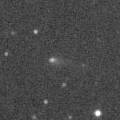
|
Now it is 16.6 mag (Oct. 5, Yasukazu Ikari). It keeps 16 mag until November. Then it keeps observable in good condition until January when it becomes fainter than 18 mag.
Date(TT) R.A. (2000) Decl. Delta r Elong. m1 Best Time(A, h)
Oct. 27 3 1.54 1 7.5 1.109 2.076 161 16.4 0:43 ( 0, 56)
Nov. 3 2 56.71 1 3.0 1.112 2.086 164 16.4 0:11 ( 0, 56)
|

|
Although it had been unobservable for a long time, now it is appearing in the morning and getting higher gradually. It must be already bright as 17 mag. It keeps observable at 16.5 mag in good condition for a long time until next April.
Date(TT) R.A. (2000) Decl. Delta r Elong. m1 Best Time(A, h)
Oct. 27 10 28.18 10 44.4 2.356 2.019 58 16.6 4:50 (286, 39)
Nov. 3 10 42.44 9 40.6 2.298 2.025 61 16.6 4:56 (291, 42)
|

|
It will reach to 15 mag in 2009 and 2010. Although LINEAR reported it as 19 mag in mid September, it will be observable at 16.5 mag in good condition until winter in this year.
Date(TT) R.A. (2000) Decl. Delta r Elong. m1 Best Time(A, h)
Oct. 27 5 34.54 22 46.1 3.397 4.096 128 16.9 3:16 ( 0, 78)
Nov. 3 5 32.76 22 51.3 3.311 4.087 136 16.8 2:46 ( 0, 78)
|
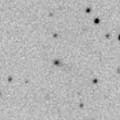
|
It was observed at 16.5-17 mag in last winter. It will be observable in good condition also in next winter. It is expected to reach to 16 mag. However, Mt. Lemmon Survey reported it so faint as 19 mag in September and October. It was observed so faint around the perihelion passage in the previous apparition at the discovery. So maybe it suddenly faded out before the perihelion passage again.
Date(TT) R.A. (2000) Decl. Delta r Elong. m1 Best Time(A, h)
Oct. 27 8 0.29 21 47.6 4.095 4.303 95 16.9 4:50 (317, 73)
Nov. 3 8 3.05 21 57.7 3.984 4.297 101 16.8 4:56 (340, 76)
|
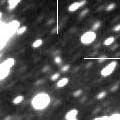
|
Now it is 17.5 mag (Sept. 16, Ken-ichi Kadota). It is outside of Jupiter's orbit. So it keeps 17 mag for a long time until winter. It keeps locating high and observable in good condition for a long time after this because it moves in the northern sky.
Date(TT) R.A. (2000) Decl. Delta r Elong. m1 Best Time(A, h)
Oct. 27 2 55.25 28 0.1 3.266 4.215 160 16.9 0:37 ( 0, 83)
Nov. 3 2 50.81 26 37.2 3.274 4.248 167 16.9 0:05 ( 0, 82)
|
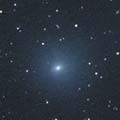
|
It passed near by the earth in early April, and reached to 8.7 mag (Apr. 10, Werner hasubick). Then it faded down to 11.8 mag on May 26 (Seiichi Yoshida), and became too low to observe in the evening. It has already faded down to 17.4 mag (Oct. 5, Yasukazu Ikari).
Date(TT) R.A. (2000) Decl. Delta r Elong. m1 Best Time(A, h)
Oct. 27 4 36.42 30 33.6 1.665 2.513 140 17.0 2:19 ( 0, 86)
Nov. 3 4 5.94 29 41.1 1.660 2.586 153 17.3 1:21 ( 0, 85)
|

|
Peculiar asteroid moving on a cometary orbit. It was asteroidal at 18 mag in late August. It will reach to 15 mag in February and March. In the Northern Hemisphere, it keeps observable until July when it becomes fainter than 18 mag. It may show a cometary activity after this, although the perihelion distance is somewhat large as 1.8 A.U.
Date(TT) R.A. (2000) Decl. Delta r Elong. m1 Best Time(A, h)
Oct. 27 8 10.38 -13 16.9 1.847 2.028 85 17.1 4:50 (341, 40)
Nov. 3 8 23.15 -15 20.3 1.766 1.993 87 17.0 4:56 (348, 39)
|
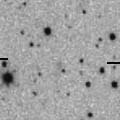
|
Now it is 17.4 mag (Sept. 16, Ken-ichi Kadota). It will be observable at 17 mag for a long time until 2008 autumn.
Date(TT) R.A. (2000) Decl. Delta r Elong. m1 Best Time(A, h)
Oct. 27 19 7.84 16 1.6 5.976 5.893 80 17.1 18:36 ( 59, 59)
Nov. 3 19 7.90 15 55.0 6.077 5.900 75 17.1 18:30 ( 65, 55)
|
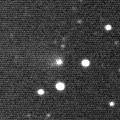
|
It was observed bright as 14-15 mag in 2004 and 2005. Now it is close to the aphelion, but it will be observable at 17.5 mag in good condition in 2007 autumn.
Date(TT) R.A. (2000) Decl. Delta r Elong. m1 Best Time(A, h)
Oct. 27 3 7.37 5 16.2 3.899 4.857 162 17.6 0:49 ( 0, 60)
Nov. 3 3 3.04 5 4.6 3.893 4.866 167 17.6 0:17 ( 0, 60)
|
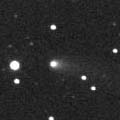
|
It reached to 13.5 mag and became visible visually in 2005 and 2006. Now it has gone far away. But it is still bright as 16.4 mag (Oct. 6, Ken-ichi Kadota), brighter than this ephemeris. It locates in the good position in this winter, so it will be observable at 17 mag for some more time.
Date(TT) R.A. (2000) Decl. Delta r Elong. m1 Best Time(A, h)
Oct. 27 2 4.79 7 6.1 3.188 4.179 174 17.7 23:42 ( 0, 62)
Nov. 3 2 0.21 6 51.4 3.215 4.194 169 17.7 23:10 ( 0, 62)
|

|
It will reach to 13 mag in 2010. Now it is around the aphelion, but it will be observable at 17 mag in good condition in autumn and winter.
Date(TT) R.A. (2000) Decl. Delta r Elong. m1 Best Time(A, h)
Oct. 27 8 55.58 25 24.4 4.418 4.425 83 17.8 4:50 (286, 65)
Nov. 3 8 58.98 25 28.2 4.298 4.413 90 17.7 4:56 (295, 71)
|

|
New bright comet of 16 mag. However, it will fade out rapidly after this, and will be unobservable quickly. It will be fainter than 18 mag in late October.
Date(TT) R.A. (2000) Decl. Delta r Elong. m1 Best Time(A, h)
Oct. 27 10 12.61 25 42.0 0.642 0.960 67 17.9 4:50 (271, 50)
Nov. 3 10 16.76 26 21.3 0.683 1.039 74 18.3 4:56 (274, 56)
|
|
![]()
 29P/Schwassmann-Wachmann 1
29P/Schwassmann-Wachmann 1 93P/Lovas 1
93P/Lovas 1 P/2007 H1 ( McNaught )
P/2007 H1 ( McNaught ) C/2006 OF2 ( Broughton )
C/2006 OF2 ( Broughton ) 46P/Wirtanen
46P/Wirtanen C/2006 S5 ( Hill )
C/2006 S5 ( Hill ) C/2006 XA1 ( LINEAR )
C/2006 XA1 ( LINEAR ) 110P/Hartley 3
110P/Hartley 3 C/2006 K4 ( NEAT )
C/2006 K4 ( NEAT ) C/2006 U6 ( Spacewatch )
C/2006 U6 ( Spacewatch ) C/2005 L3 ( McNaught )
C/2005 L3 ( McNaught ) 50P/Arend
50P/Arend C/2006 V1 ( Catalina )
C/2006 V1 ( Catalina ) 188P/2007 J7 ( LINEAR-Mueller )
188P/2007 J7 ( LINEAR-Mueller ) C/2007 G1 ( LINEAR )
C/2007 G1 ( LINEAR ) C/2006 K1 ( McNaught )
C/2006 K1 ( McNaught ) C/2006 W3 ( Christensen )
C/2006 W3 ( Christensen ) C/2007 B2 ( Skiff )
C/2007 B2 ( Skiff ) C/2005 EL173 ( LONEOS )
C/2005 EL173 ( LONEOS ) (3200) Phaethon
(3200) Phaethon C/2006 K3 ( McNaught )
C/2006 K3 ( McNaught ) 191P/2007 N1 ( McNaught )
191P/2007 N1 ( McNaught ) 70P/Kojima
70P/Kojima 74P/Smirnova-Chernykh
74P/Smirnova-Chernykh 173P/2005 T1 ( Mueller 5 )
173P/2005 T1 ( Mueller 5 ) C/2006 M1 ( LINEAR )
C/2006 M1 ( LINEAR ) C/2007 E1 ( Garradd )
C/2007 E1 ( Garradd ) 2005 WY3
2005 WY3 C/2005 S4 ( McNaught )
C/2005 S4 ( McNaught ) P/2004 F3 ( NEAT )
P/2004 F3 ( NEAT ) 117P/Helin-Roman-Alu 1
117P/Helin-Roman-Alu 1 65P/Gunn
65P/Gunn P/2007 T2 ( Kowalski )
P/2007 T2 ( Kowalski )![]()



























